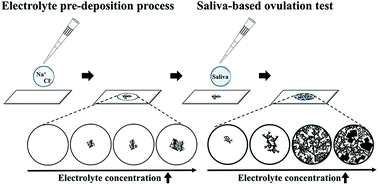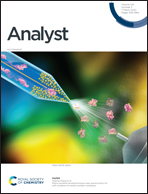Modulation of saliva pattern and accurate detection of ovulation using an electrolyte pre-deposition-based method: a pilot study†
Abstract
We developed an electrolyte pre-deposition-based saliva pattern modulation method to detect ovulation with high accuracy and reliability. Ovulation tests using human saliva have advantages in terms of the earlier ovulation detection and more convenient sample collection procedure; however, accuracy is low, which is a critical limitation given that the concentrations of salivary constituents can vary depending on the health status of the tested individual and subjective user judgement of the test result. In this study, we quantitatively analyzed saliva patterns according to the concentrations of electrolytes and proteins in the ovulation test and found that changes in the saliva pattern during the ovulatory period can be controlled by sodium chloride (NaCl) pre-deposition, which directly affects the accuracy of ovulation detection. The 100 nmol NaCl pre-deposition condition proved optimal, being two-fold more sensitive to changes in saliva pattern versus the non-pre-deposition condition (accuracy of ovulation detection = 66.6% and 33.3%, respectively). Although accuracy remained insufficient for actual applications compared to the urine-based ovulation detection method, we expect that the electrolyte pre-deposition method will greatly contribute to enhancing the performance of saliva-based ovulation detection tests, toward a commercially satisfactory level of accuracy.



 Please wait while we load your content...
Please wait while we load your content...